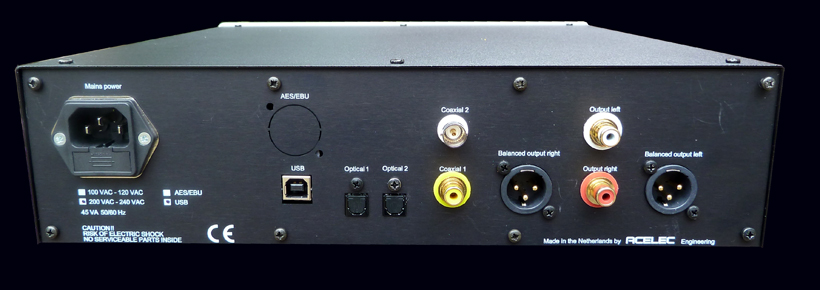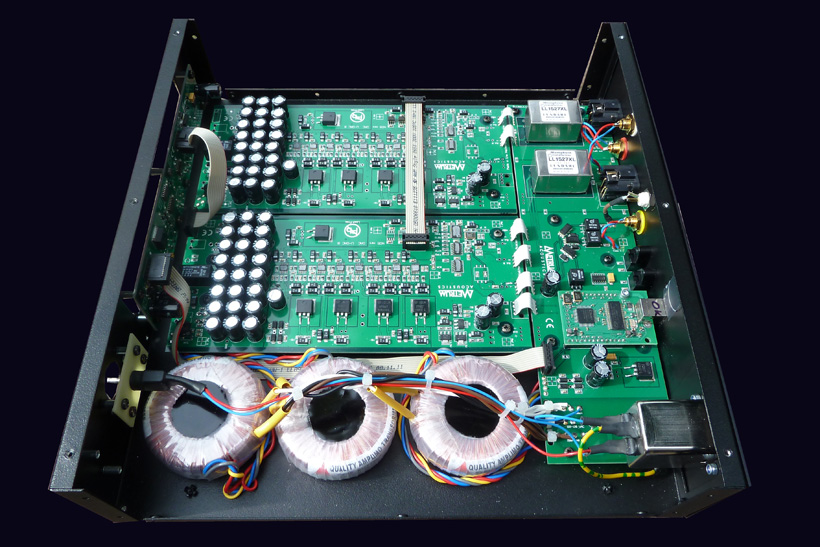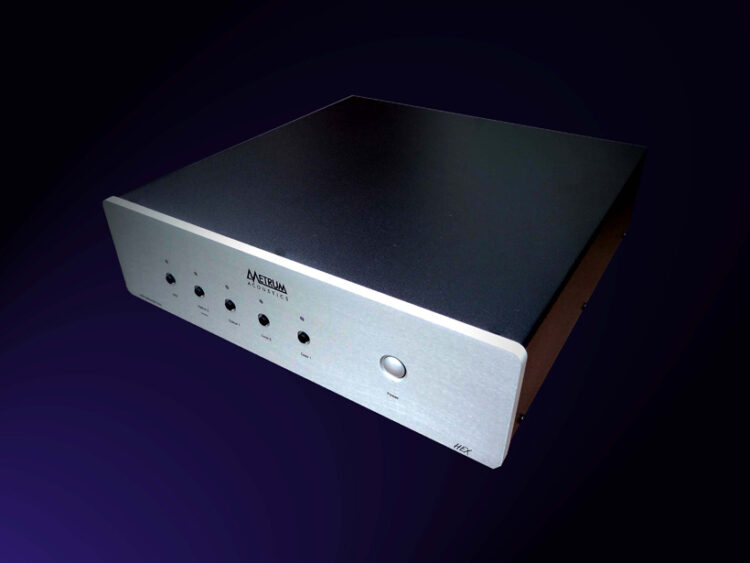For as long as I can remember D/A-converters have intrigued me and as a result these little boxes prey on my wallet from time to time. I have owned quite a few, ranging from Audio Alchemy, TEAC and Apogee to PS Audio and I still possess one of the first Sony’s (a 1985 example). I have reviewed a lot more of them and it was no wonder that some years ago a one man company (in those days) approached me and handed over his first converter for a review. He started off with the Metrum Acoustics Duo and Quattro DACs named after the number of converter chips inside the box. They were amazing products at a very attractive prices and they outperformed many other competing brands. Later the Octave DAC appeared and outboard power supplies were introduced, forums picked up the rumours around the Octave and within a few months units were being shipped worldwide. But this wasn’t enough, mister Metrum Acoustics, Cees, Ruijtenberg, was asked for more. People wanted a USB input, balanced outputs, an AES/EBU input and a case that looked more like other high end products. The result is in front of me, the Metrum Acoustics Hex, short for hexadecimal.
Hexadecimal
There’s no need to ask what the name is all about: eight converter chips on each channel makes sixteen in total. These converters remain the secret in all Metrum Acoustics products. According to the manufacturer the industrial high speed converters used are professional ones that were never meant to be used in consumer electronics. They are fast, a lot faster than any normal D/A-converter from Burr Brown, Crystal, AKM and the like. Converting even 24 bits signals at 192kHz is a piece of cake. It’s probably because Cees Ruijtenberg’s background is nautical instruments and radar. He also loves music and is a long time manufacturer of handmade electrostatic loudspeakers and amplifiers. But a chip or even a handful of chips does not a decent D/A-converter make. Metrum Acoustics chose non-oversampling chips for sound quality reasons and it’s easy to hear why, upsampling is buzz word yet its effect can be to make music sound more artificial.
Doubling the number of DAC chipsets in the Octave resulted in a lower noise floor, less distortion and improved resolution according to Metrum Acoustics. The PCBs have also been doubled to operate in full differential mode and because galvanic isolation between boards was desired a total of three toroidal transformers and 18 voltage regulators are used to feed the DAC boards while one transformer is for control logic and USB. Jitter is reduced in the Hex with the help of data buffering technology and nearly all inputs will handle 24bit/192kHz signals, Toslink is limited to 24bit/96kHz. Outputs are both balanced and single ended. In the single ended signal path a pair of Lundahl transformers converts the 4 Volt balanced signal into a 2 Volt single ended one. The standard Hex has two optical Toslink inputs and two coaxial inputs, one RCA and one BNC. An AES/EBU input module is optional and replaces one optical input, USB is optional as well, with technology and drivers supplied by M2Tech.

Competition
My system comprises an Esoteric D-07 D/A converter fed by a NAD M50 digital music player with a balanced digital cable by Apogee. The M50 is my main source of music these days with a ripped CD collection and a lot of high resolution FLAC, ALAC and WAV files. The Metrum Acoustics Hex is used in just the same way as the Esoteric most of the time. It is connected by means of balanced Yter cables to my Audia Flight Strumento No.1 preamp and an Audia Flight Class A 50 Watt power amp. It was also used with a Stereovox digital cable on the RCA input and with Crystal Cable interconnects for single ended use. I also experimented with a Canare BCJ-XP-TRB impedance transformer (75 Ohm BNC to 110 Ohm XLR) with very good results. Loudspeakers are PMC fact.8 and whatever was around for reviewing purposes at the time. A lot of attention went into the mains, think of filters, special cables and separate wiring from the mains power entrance point in my house. A system put together to be capable of revealing differences between products but ultimately composed for music reproduction. The Esoteric DAC is supposed to be stiff competition for the Hex, so let us find out what it’s capable off.
Having fun
I started the way I guess most people will use the DAC: S/PDIF coaxial input and RCA cables between DAC and preamplifier. I selected some of my favourite tracks like Paper Airplane by Alison Krauss & Union Station, Jardin d’Hiver by Stacey Kent and Six Blade Knife by Dire Straits. Excellent voices came my way from the two ladies and one guy. There was absolutely no digital artefacts nor a single tone that went over the edge in the high frequencies. Most impressive however were the guitars that offered both the attack of the strings and the sound of the instrument itself. A clear sound with a lot of energy in a fine stereo image. On the Stacey Kent track the bass was even and easy to follow, the grand piano had a full body and I really enjoyed the performance. You don’t have to play very loud to get a complete picture of what the Hex is capable of, whatever the volume it’s always very friendly to the ear and I could listen for hours without getting tired.
From the moment I had my first professional Apogee DAC at home I became very fond of balanced digital connections. But not every digital source offers an XLR output so you can use an outboard impedance transformer in between your coaxial cable and XLR input, like I did with the Hex and in the past with other converters. It works and somehow you get closer to an analogue-like reproduction. The soundstage gets a little wider, even more energy is added and you experiences more depth, although I have to admit Ms Krauss' voice is not as tender as before. On the Stacey Kent track you not only hear the bass but also a clear distinction between the bass drum and the plucked instrument (to be honest, my Esoteric is not capable of this degree of separation). Which proves that the connection sets the limit and not the converter itself, which handles every signal in the most natural way. I am certain that in the long run I will be happier with the more rounded sound of the transformer than the direct input through RCA. But which you prefer will depend on the amplifier, speakers and room acoustics.
I am blessed with a digital music player with an XLR output, which meant the next step was to connect the Hex with a balanced digital cable from the source. But I stayed with RCA output into the preamp. On the Krauss track the difference went far beyond expectation, I was no longer just enjoying Alison's voice, I could fall in love with her. Gone is the slight sharpness caused by the transformer, artists are placed in a much wider soundstage and more space is added yet it sounds more coherent at the same time. This was less clear with the Stacey Kent piece, she only took a small step forward, leaving the band behind her. I didn’t notice an increase in detail or a change of sound, at least I thought not, on a second run I realised that more percussion was coming my way, there was more life in the sound.

Mark Knopfler is no different from the rest, he steps forward, the guitar is a little more rounded, the drums have more energy, the complete picture is perfectly natural. There was never any lack of neutrality with the Hex, but there is even more this way. This might be due to the rest of the system, which was set up with balanced connections all the way. What would happen when I changed the output to XLR, too? Well, I have to admit, not as much as I expected. The steps made from RCA to the Canare transformer and up to XLR on the input side were more influential. A little more space is noticeable and the sound is more removed from the speakers, but these are small changes. Somehow the Lundahl transformers in the output stage of the Hex do a very good job. Where most manufacturers simply use an op-amp or just half of the balanced signal inside the box to connect the RCA’s, Metrum Acoustics aimed for the best sound quality even though it costs a lot more than a pair of cheap devices. This is what you get if the designer and the manufacturer are just one person and no marketing department gets in between the company and the customer. You end up with a product as it was originally intended to be.
Once I had tried all the connecting options one by one in a decent way I wanted some more music. Cue Donna Summer with Love To Love You Baby, just to clear the ears. Although it’s a lousy recording I still enjoyed it thanks to the Hex DAC. But do not play that song too loud, because your neighbours will give your wife strange looks! It was time to add classical music to the playlist, specifically Dutch violinist Janine Jansen with her interpretation of Vivaldi’s Four Seasons. A lady with an enormous passion for music and a strong personality on stage, her Four Seasons is played with a lot of passion to the very end, the best part is Summer, it hits you like a steamroller. This is not the way Alan Loveday would play the piece, neither is it as Nigel Kennedy once recorded it, it’s somewhere in between. Janine is able to play extremely tenderly in one part and to almost torture her instrument in the next one. A pleasure to listen to with the Hex in place. Immediately conspicuous and very natural-sounding is the cleanliness of the converter's sound, which is not common. When you measure an electronic device you often get good results but under dynamic conditions the music is modulated by noise in the circuits, bringing a sonic harassment that makes you tired. The Hex is always clean, pure and undisturbed in the way it handles a digital signal. For instance with Janine Jansen, you listen and listen and never get bored. Suddenly, unexpectedly, the music comes to an end. I would rather it had gone on and on. This lack of noise separates the boys from the men and the mediocre D/A converters from the mature ones. I also recognised this characteristic in the more affordable Metrum Acoustics DACs, it appears to be one of the designer’s strong points.

How about
How about a quick comparison between the Octave and the Hex DACs? I took the Hex to a friend who has an Octave in daily use and connections were made with the same kind of analogue interconnects, although we had to use an optical cable for the Hex and a digital coaxial cable for the Octave due to the layout of his setup. So the Hex has a small disadvantage, at least on paper. The Hex played a little bit louder, which made A-to-B comparison a little more difficult. The first thing we noticed is the family resemblance between the two converters. Listen to Diana Krall on the Octave and her voice is in the lead, turn to the Hex and the orchestra is combined with the voice. Some new layers are added to the rendering, for instance when you listen to brushed cymbals via the Hex you suddenly notice the air resonance of the drumhead beneath the cymbal. Let's make a change from hi-fi into reality. A grand piano gains realism due to a richer sound; the bass range and the extreme high frequencies are better balanced with the midrange, the soundstage opens up even further and becomes a few meters broader. Attack is better all the way, reproduction sounds a lot more like reality. During the evening I tried to find a way to indicate the differences in just one or two sentences and came up with this: “The Octave is like a car braking because a road junction is ahead, while the Hex speeds up on an empty motorway”. My conclusion would be to exchange an Octave for a Hex as soon as I had saved enough money. To prove the quality of the original Octave, my friend plans to keep the Octave and change from a Logitech Squeezebox Touch to a better digital music player first and then purchase a Hex.
Summary
I know the Metrum Acoustics Hex DAC is of Dutch origin, just as I am, but I promise that no patriotic feelings play any role or have become part of the conclusion. I can honestly state that I like the Hex a lot, an awful lot and if no Esoteric was around it would end up as the number one on my shortlist. It is very detailed but never over the edge, which means it never becomes technical in any sense, the sound is clean and entirely free from noise under dynamic conditions. This device was made by a music lover for other music lovers. The tonal balance is very consistent: bass, midrange and treble are perfectly balanced on either RCA or XLR outputs. It does not sound warm nor bright, just natural but if you are looking for coloration you could say that voices are minimally boosted in a positive way. For me USB is not an issue, I dislike tinkering with drivers and software. I prefer a NAS and network player, but if you need USB, the Hex has all the possibilities. Wisely they chose the well-known M2Tech USB driver solution and did not start again from scratch. Take the XLR way as the main input for your favourite source if you can. Save the RCA and optical inputs for TV decoders etc. Make a choice between the outputs, but both will serve you well. Due to the direct sales policy this D/A converter is cheap compared to other brands, which is an advantage for any buyer looking for a very, very good DAC. Strongly recommended.


